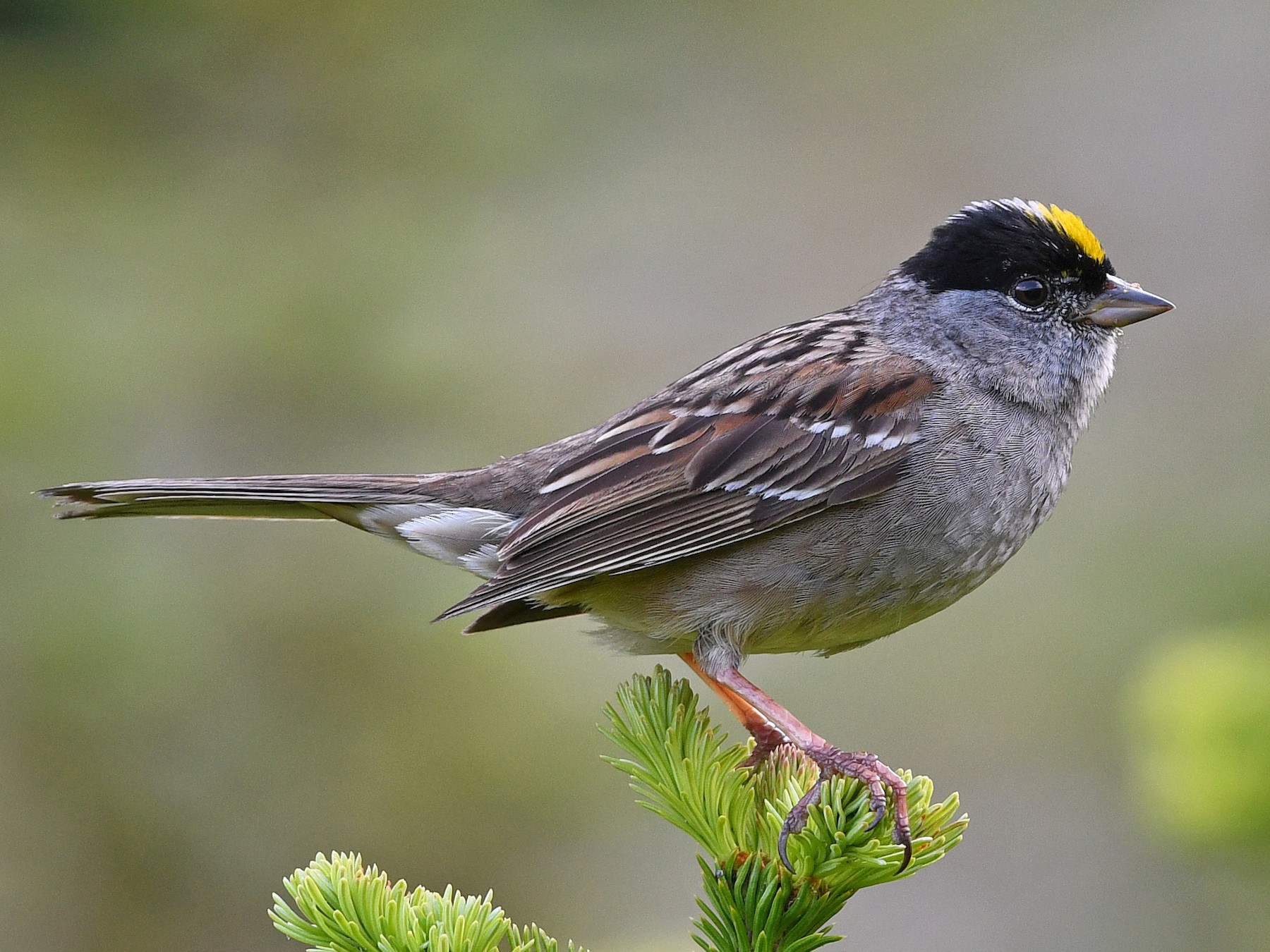Identifying brown birds or LBJs (little brown jobs) can pose a challenge as they lack the distinct characteristics of their more vibrant counterparts. However, fret not! This comprehensive guide will aid you in recognizing various brown bird species like sparrows, wrens, and others commonly found in Alaska. Additionally, you’ll discover which brown birds frequent Alaska during different seasons.
To facilitate your identification process, this guide presents a list of brown birds commonly observed in Alaskan backyards, woods, and fields. The birds are arranged in order of their prevalence based on checklists submitted by bird watchers on ebird.
Brown Birds in Alaska by Season
Brown Birds in Alaska Throughout the Year: Song Sparrow, Pine Siskin, Chestnut-backed Chickadee, Brown Creeper, Northern Flicker
Brown Birds in Alaska During Summer: American Robin, Savannah Sparrow, White-crowned Sparrow, Hermit Thrush, Golden-crowned Sparrow, Swainson’s Thrush, Northern Waterthrush, American Tree Sparrow, Common Yellowthroat, Cedar Waxwing, Chipping Sparrow
Rare or Accidental Species in Alaska: White-throated Sparrow, Purple Finch, Brown-headed Cowbird, Swamp Sparrow, Spotted Towhee, House Sparrow, Mourning Dove, House Finch, Eastern Phoebe, Marsh Wren, Rose-breasted Grosbeak, American Goldfinch, Great Crested Flycatcher, Wood Thrush, Brown Thrasher
31 Brown Birds in Alaska
1. American Robin

American Robins are present in Alaska during their breeding season, and they appear in 34% of checklists during summer. They are primarily sighted from April to September, but some individuals remain in the state throughout the year, featuring in 4% of winter checklists.
American Robins can commonly be observed on lawns, where they feed on earthworms. They possess black heads and backs with red or orange breasts. During winter, they tend to roost in trees, making backyard sightings more likely in spring.
- Turdus migratorius
- Length: 7.9-11.0 inches (20-28 cm)
- Weight: 2.7-3.0 ounces (77-85 g)
- Wingspan: 12.2-15.8 inches (31-40 cm)
American Robins are residents of the lower 48 states, as well as the western coast of Canada and Alaska. Those that breed in Canada and inland Alaska migrate south for winter.
American Robins can be found in a variety of habitats, including woodlands, forests, mountains, fields, parks, and lawns. Their diet consists of earthworms, insects, snails, and fruit.
To attract American Robins to your backyard, provide sunflower seeds, suet, peanut hearts, fruit, and mealworms. Platform feeders are recommended, or scatter food on the ground. Additionally, consider planting native berry-producing plants like juniper, sumac, hawthorn, and dogwood.
2. Savannah Sparrow
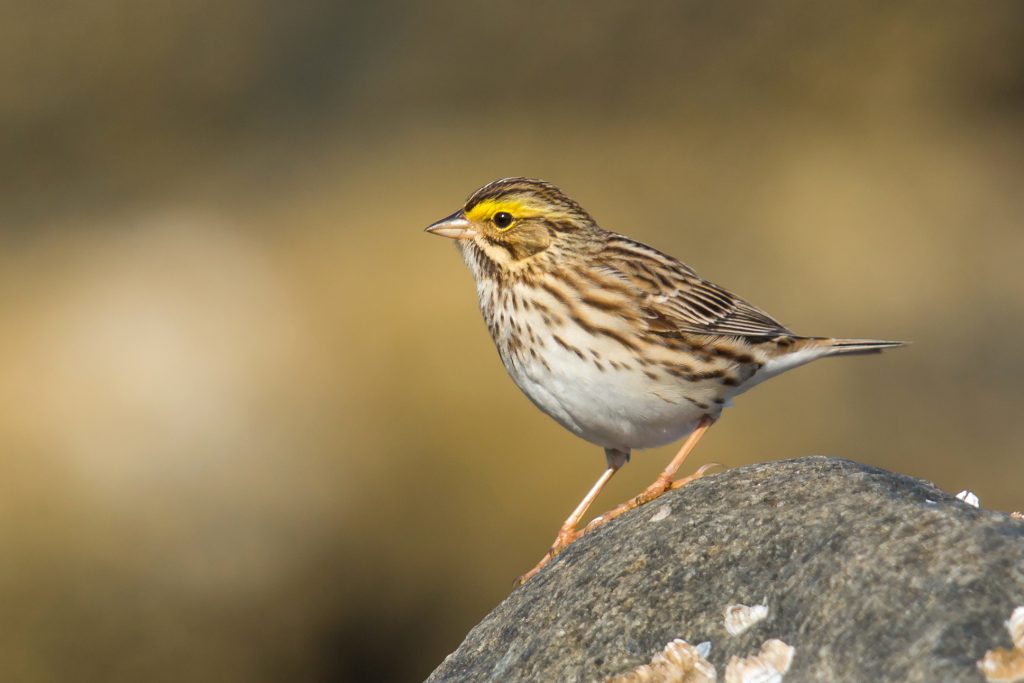
Savannah Sparrows spend their breeding season in Alaska and are observed in approximately 18% of summer checklists. They are most commonly seen from April to November, although a few individuals remain throughout the year.
Upon closer observation, Savannah Sparrows reveal a distinct yellow patch near their eyes. They also possess short tails and display streaky brown plumage.
- Passerculus sandwichensis
- Length: 4.3-5.9 inches (11-15 cm)
- Weight: 0.5-1.0 ounce (15-28 g)
- Wingspan: 7.9-8.7 inches (20-22 cm)
Savannah Sparrows breed in Canada and the United States before migrating to southern states and Mexico for the winter.
These sparrows can be found on the ground in open areas such as grasslands, foraging for insects and spiders during the breeding season and seeds during winter.
Savannah Sparrow nests are situated on or near the ground and constructed from grass. They lay up to six eggs, which take approximately two weeks to hatch, with an additional one to two weeks for the young to fledge.
Although they do not frequently visit feeders, Savannah Sparrows may occasionally visit your yard if you maintain brush piles, have long grass, and reside near fields.
3. White-crowned Sparrow

White-crowned Sparrows are primarily observed in Alaska during their breeding season from May to August. While most migrate south for the winter, a few individuals remain in the state throughout the year. They are recorded in 18% of summer checklists and 3% of winter checklists.
White-crowned Sparrows are large grayish sparrows with long tails, small bills, and striking black and white stripes on their heads.
- Zonotrichia leucophrys
- Length: 5.9-6.3 inches (15-16 cm)
- Weight: 0.9-1.0 ounce (25-28 g)
- Wingspan: 8.3-9.4 inches (21-24 cm)
White-crowned Sparrows breed in Alaska and Arctic Canada before migrating south to the lower 48 states and Mexico for winter. However, some individuals may remain along the Pacific Coast and in mountainous regions throughout the year.
You can find White-crowned Sparrows in weedy fields, along roadsides, forest edges, and yards, where they forage for weed and grass seeds, as well as fruits like elderberries and blackberries.
To attract White-crowned Sparrows to your backyard, provide sunflower seeds, as they may also consume seeds dropped by other birds at the feeders.
4. Song Sparrow
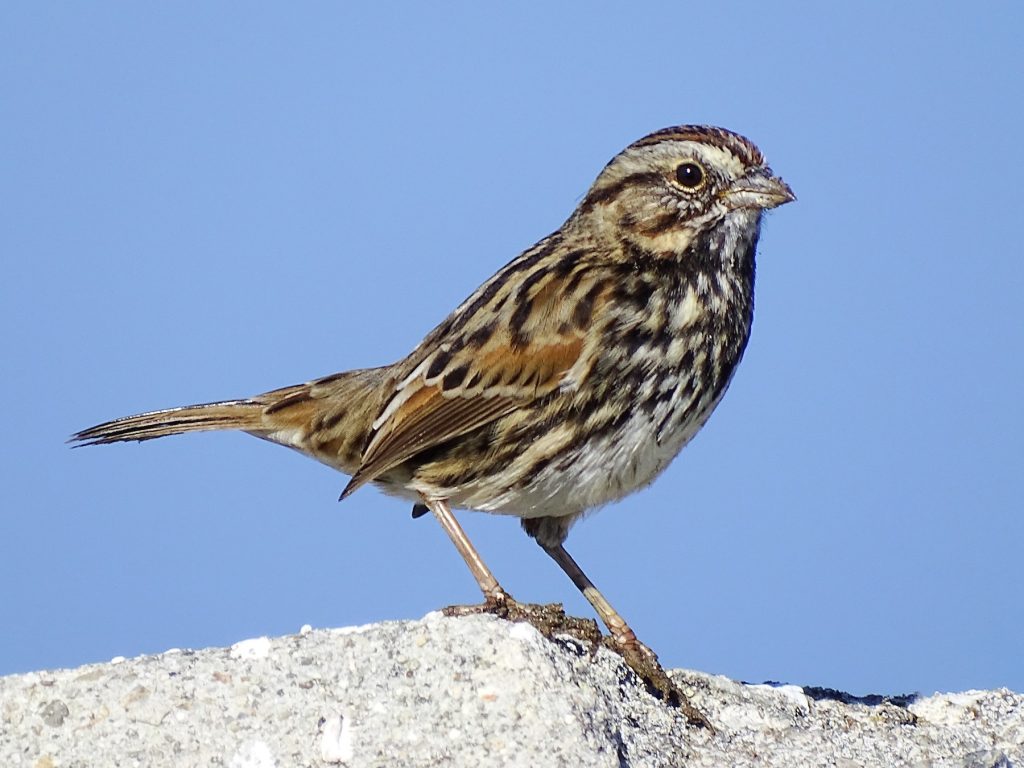
Song Sparrows can be observed throughout the year in Alaska, with a higher concentration in the southern regions of the state along the coast. They appear in 8% of summer checklists and 11% of winter checklists.
Although not as visually striking as some other backyard birds, Song Sparrows utilize their constant melodic song to attract mates during the spring and summer seasons.
- Melospiza melodia
- Length: 4.7-6.7 inches (12-17 cm)
- Weight: 0.4-1.9 ounces (12-53 g)
- Wingspan: 7.1-9.4 inches (18-24 cm)
Song Sparrows are year-round residents in the northern states of the United States. Those that breed in Canada migrate to southern states for the winter.
They can be found in open, shrubby, and wet areas, often perched on low shrubs while singing. Additionally, they are frequently observed at backyard feeders.
Song Sparrows possess a varied diet, including insects such as beetles, caterpillars, midges, spiders, and earthworms. They also consume buckwheat, sunflower, raspberries, wild cherries, blackberries, wheat, and rice.
To attract Song Sparrows to your backyard feeders, provide black oil sunflower seeds, cracked corn, and nyjer.
A remarkable variety of sparrows can be spotted in Alaska, and familiarizing yourself with their songs and intriguing facts will significantly aid in their identification.
5. Pine Siskin
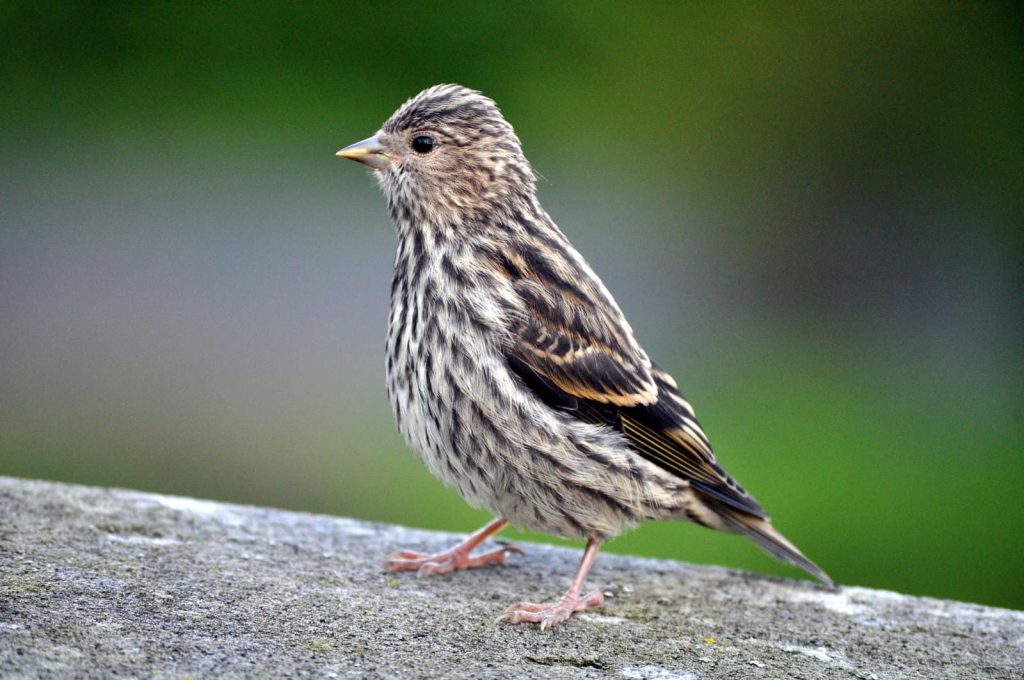
Pine Siskins are observed during migration in western Alaska and throughout the breeding season in the eastern region. However, some individuals remain in the southern part of the state all year round. They are recorded in 8% of summer checklists and 11% of winter checklists.
Pine Siskins are small finches with brown plumage adorned with yellow streaks on their wings and tail. They feature forked tails, pointed wings, and short, pointed bills.
- Spinus Pinus
- Length: 4.3-5.5 inches (11-14 cm)
- Weight: 0.4-0.6 ounce (12-18 g)
- Wingspan: 7.1-8.7 inches (18-22 cm)
Pine Siskins remain year-round in pine forests across the western states and along the Canadian border. Some also breed in Canada before migrating south for the winter.
Their distribution spans much of North America, depending on the availability of pine cone crops. While their diet predominantly consists of conifer seeds, they also consume young buds, grass seeds, and weed seeds.
To attract Pine Siskins to your backyard, provide thistle and nyjer seeds in feeders. They may also be enticed by black oil sunflower seeds and suet.
6. Hermit Thrush

Hermit Thrushes spend their breeding season in Alaska and appear in 13% of summer checklists. They are primarily observed from April to November.
Hermit Thrushes possess an upright posture, chunky bodies, and long tails. Their backs are brown, while their undersides are white, adorned with spots on the throat and breast.
- Catharus guttatus
- Length: 5.5-7.1 inches (14-18 cm)
- Weight: 0.8-1.3 ounces (23-37 g)
- Wingspan: 9.8-11.4 inches (25-29 cm)
Hermit Thrushes breed in Canada, northeastern and western US states. During migration, they can be seen in central states before wintering along the Pacific Coast, southeastern states, and in Mexico.
These thrushes forage on the ground in forest clearings, searching for insects. In winter, they also consume berries.
While they are not regular visitors to backyards, their melancholic songs can be heard during the spring and summer seasons.
7. Chestnut-backed Chickadee

Chestnut-backed Chickadees are year-round residents of Alaska, primarily spotted in the southeastern region. They are recorded in 4% of summer checklists and 11% of winter checklists.
These tiny birds boast black caps and throats, white cheeks, and rich chestnut-colored backs and sides. However, in California, their sides appear gray instead of brown.
- Poecile rufescens
- Length: 3.9-4.7 inches (10-12 cm)
- Weight: 0.3-0.4 ounce (7-12 g)
- Wingspan: 7.5 inches (19 cm)
Chestnut-backed Chickadees form flocks and inhabit wet evergreen forests along the Pacific Coast. They frequently visit backyard feeders.
You can usually find Chestnut-backed Chickadees in conifer forests, where they predominantly feed on insects such as caterpillars, spiders, wasps, and aphids. They also consume seeds, berries, and fruits.
Their nests are typically constructed in holes within rotten wood, either by the birds themselves or by utilizing old woodpecker nests.
To attract Chestnut-backed Chickadees to your yard, offer black oil sunflower seeds, suet, nyjer, peanuts, mealworms, or
place them in tube feeders, platform feeders, or suet cages. They may also utilize nest boxes.
8. Golden-crowned Sparrow
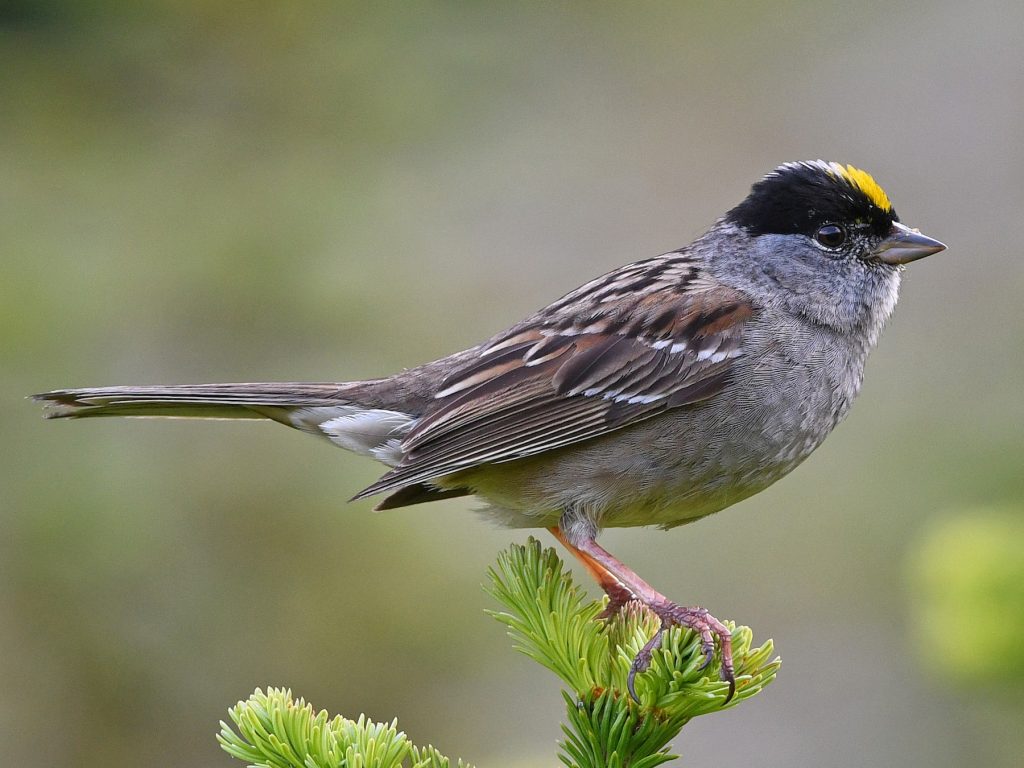
While some Golden-crowned Sparrows can be observed throughout the year, they are more commonly seen during the breeding season in Alaska from May to September. They appear in 8% of summer checklists and 2% of winter checklists.
Golden-crowned Sparrows feature grayish-brown plumage underneath and streaked brown on their backs. Their heads display a black crown and a bright yellow forehead.
The colors of Golden-crowned Sparrows become duller during winter, with the crown appearing brown and the forehead exhibiting a less vibrant yellow.
- Zonotrichia atricapilla
- Length: 5.9-7.1 inches (15-18 cm)
- Weight: 1.1-1.2 ounces (30-33 g)
Golden-crowned Sparrows breed in Alaska and western Canada before migrating to the West Coast for the winter.
These sparrows can be found foraging in weedy fields, scratching for seeds such as dock, sumac, and geranium. They also consume fruits like apples, grapes, elderberries, and olives. Insects, including ants, beetles, butterflies, and termites, supplement their diet.
To attract Golden-crowned Sparrows to your backyard, offer seeds in ground feeders or plant native fruit-producing plants.
9. Swainson’s Thrush

Swainson’s Thrushes are primarily observed in Alaska from May to September, appearing in 9% of summer checklists.
These medium-sized thrushes possess pale undersides with spotted chests and brown plumage on their backs.
- Catharus ustulatus
- Length: 6.3-7.5 inches (16-19 cm)
- Weight: 0.8-1.6 ounces (23-45 g)
- Wingspan: 11.4-12.2 inches (29-31 cm)
Swainson’s Thrushes can be found in forests, foraging on the forest floor in leaf litter for insects during the breeding season. They also feed on red fruits such as blackberries, raspberries, huckleberries, and sumac. Ants contribute to their diet, and they feed other insects to their nestlings.
While they are typically only seen during migration in the lower 48 states, Swainson’s Thrushes breed in Canada and Alaska before heading south to Central and South America for winter.
To attract Swainson’s Thrushes to your backyard, provide ground-level birdbaths and ensure the presence of trees and shrubs for cover.
10. Northern Waterthrush
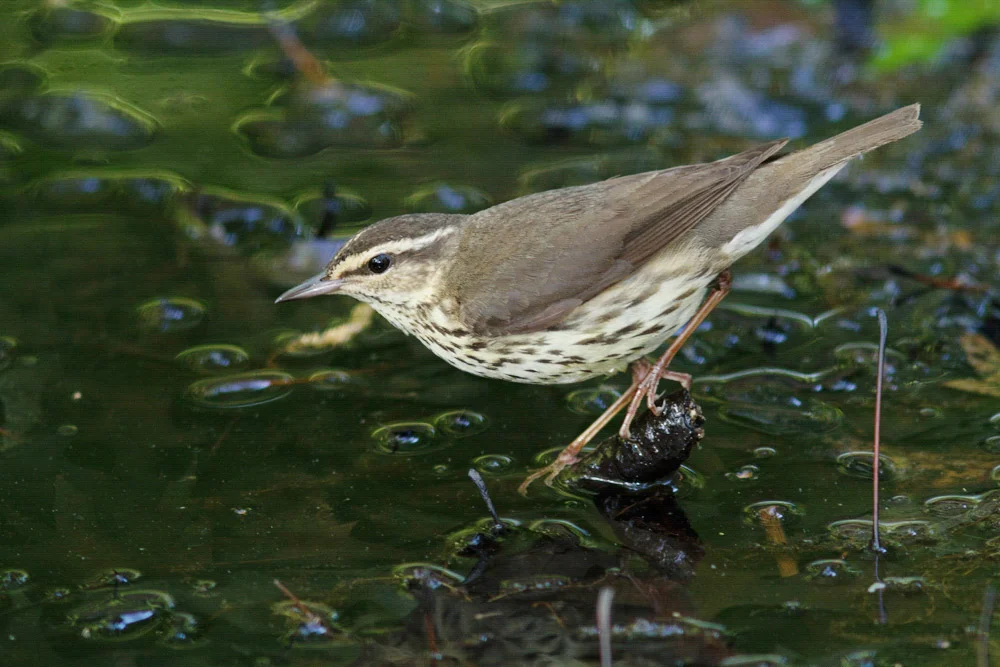
Northern Waterthrushes appear in 7% of summer checklists and are primarily observed in Alaska from May to October.
These thrush-like birds are larger in size, with both males and females exhibiting similar traits. They possess brown heads with thick, white eyebrows, dark brown backs, and white bellies adorned with heavy streaking from their throats to their rumps.
- Parkesia noveboracensis
- Length: 5.75 inches (15 cm)
- Weight: 0.8 ounce (23 g)
- Wingspan: 8.75 inches (22 cm)
Northern Waterthrushes breed in Canada, Alaska, and northeastern US states before migrating to Mexico, Central and South America, and the Caribbean. Some individuals may remain year-round in Central and South America.
These birds can be found in dark, woody swamps, thickets, and bogs. If there is still or sluggish water in the forests, chances are you will encounter a Northern Waterthrush. In tropical regions during winter, they are commonly found among mangroves.
Northern Waterthrushes exhibit both aquatic and terrestrial foraging behaviors. Their long legs enable them to walk on shallow water in search of water beetles, mosquitoes, slugs, crustaceans, snails, and occasionally small fish. They also consume caterpillars, moths, and ants found under leaves.
11. American Tree Sparrow

American Tree Sparrows spend the breeding season in Alaska and appear in 5% of summer checklists. While most migrate south for winter, a few individuals remain throughout the year, accounting for 1% of winter checklists.
American Tree Sparrows are long-tailed, brown-streaked birds with rusty caps, gray faces, and a rusty eyeline.
- Spizelloides arborea
- Length: 5.5 inches (14 cm)
- Weight: 0.5-1.0 ounce (13-28 g)
- Wingspan: 9.4 inches (24 cm)
American Tree Sparrows are winter birds in the United States and summer birds in Canada. They breed in the northern regions of Canada and Alaska and migrate to most states in the US for winter, excluding the Pacific and Gulf Coasts.
These sparrows forage in small flocks in weedy fields and beneath bird feeders.
American Tree Sparrows construct their nests on or near the ground using twigs, grass, and moss. They lay around five eggs, which hatch in just under two weeks, and the young take a little over a week to fledge.
To attract American Tree Sparrows to your backyard, provide black oil sunflower seeds, nyjer, cracked corn, and millet on platform feeders. They also feed on seeds dropped on the ground from tube feeders.
12. Brown Creeper
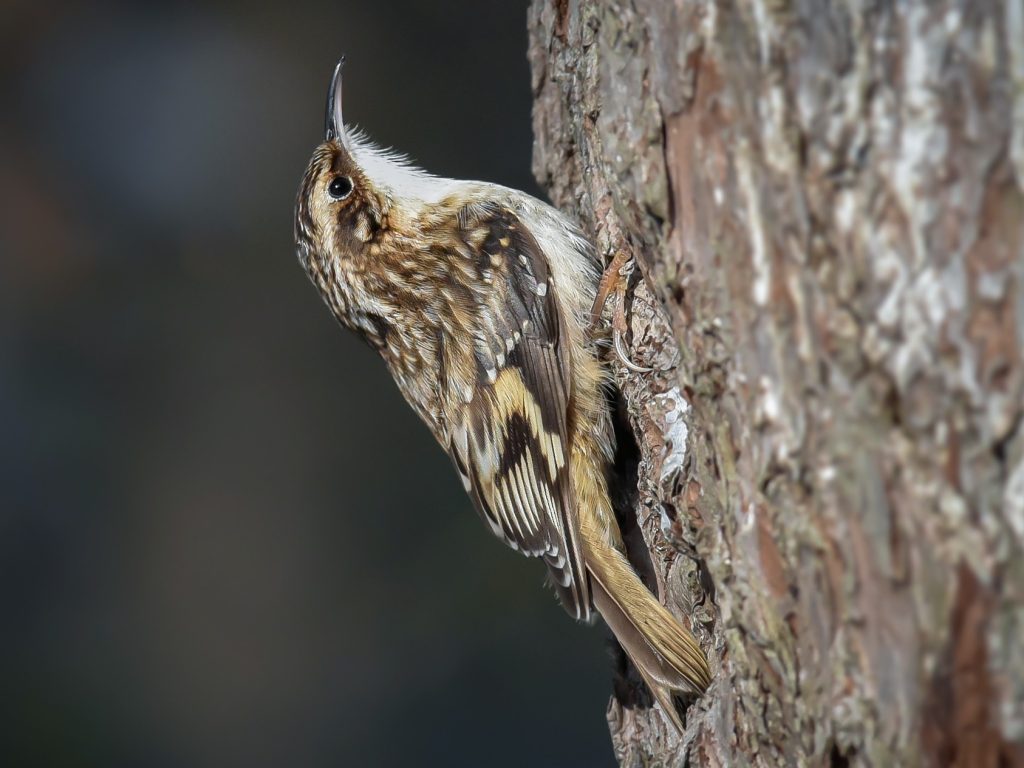
Brown Creepers can be observed throughout the year in southern Alaska, appearing in 1% of summer checklists and 3% of winter checklists.
These tiny songbirds are challenging to spot against tree trunks due to their streaked brown backs and white undersides.
- Certhia americana
- Length: 4.7-5.5 inches (12-14 cm)
- Weight: 0.2-0.3 ounce (5-10 g)
- Wingspan: 6.7-7.9 inches (17-20 cm)
Brown Creepers do not migrate but may move to lower elevations and southern regions during winter. They can be found in Alaska, southern Canada, northeastern and eastern US states, as well as parts of Mexico and Central America during certain winters.
To spot these birds, observe mature woodlands with large trees, where Brown Creepers search for insects and larvae hidden in the bark. They typically move upwards along the tree trunk, in contrast to nuthatches that face downwards.
Instead of singing, Brown Creepers emit high-pitched calls that aid in their location.
13. Northern Flicker
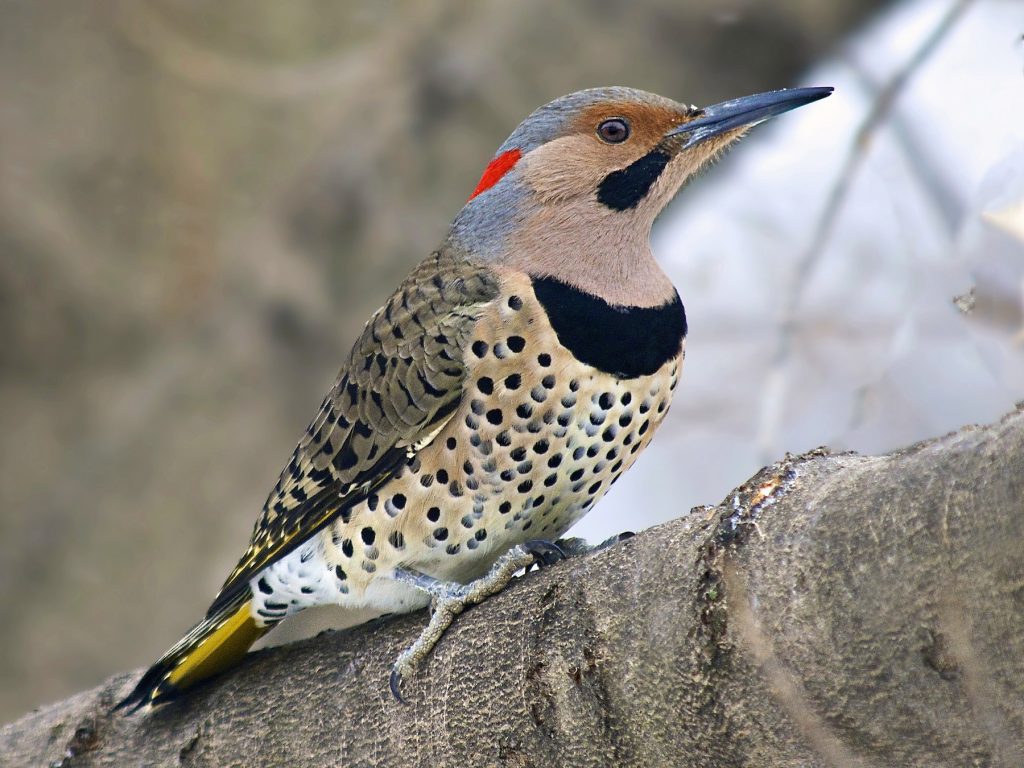
Northern Flickers migrate and can be found in Alaska during the summer. However, a few individuals may remain during winter. They appear in 2% of summer and winter checklists.
Northern Flickers are large brown woodpeckers with black spots and a white patch on their rumps when in flight. Male flickers also display a red nape of the neck.
- Colaptes auratus
- Length: 11.0-12.2 inches (28-31 cm)
- Weight: 3.9-5.6 ounces (110-160 g)
- Wingspan: 16.5-20.1 inches (42-51 cm)
Northern Flickers can be observed year-round across the United States, as well as in Canada during the summer. Those that breed in Canada migrate south for the winter.
These woodpeckers primarily feed on ants, beetles, fruits, and seeds. They are often seen on the ground, using their curved bills to dig.
To attract Northern Flickers to your backyard, provide suet. You may also attract other woodpecker species found in Alaska to your feeders.
14. Common Yellowthroat

Common Yellowthroats are not particularly common in Alaska but can be observed during the breeding season from May to mid-November in the southeastern part of the state.
These small songbirds exhibit brownish plumage on their backs and bright yellow undersides, accompanied by long tails. Males have black masks across their faces, although the brightness of the yellow may vary geographically, appearing more olive in some regions.
- Geothlypis trichas
- Length: 4.3-5.1 inches (11-13 cm)
- Weight: 0.3 ounce (9-10 g)
- Wingspan: 5.9-7.5 inches (15-19 cm)
Common Yellowthroats spend the summer breeding in most of North America, excluding Alaska and northern Canada. Some individuals remain year-round along the Gulf Coast and Pacific Southwest, while others migrate south for winter.
These birds are often found in marshy or wetland areas and brushy fields, thriving in thick, tangled vegetation.
To attract Common Yellowthroats to larger backyards, create dense vegetation and incorporate native plants that attract insects.
15. Cedar Waxwing
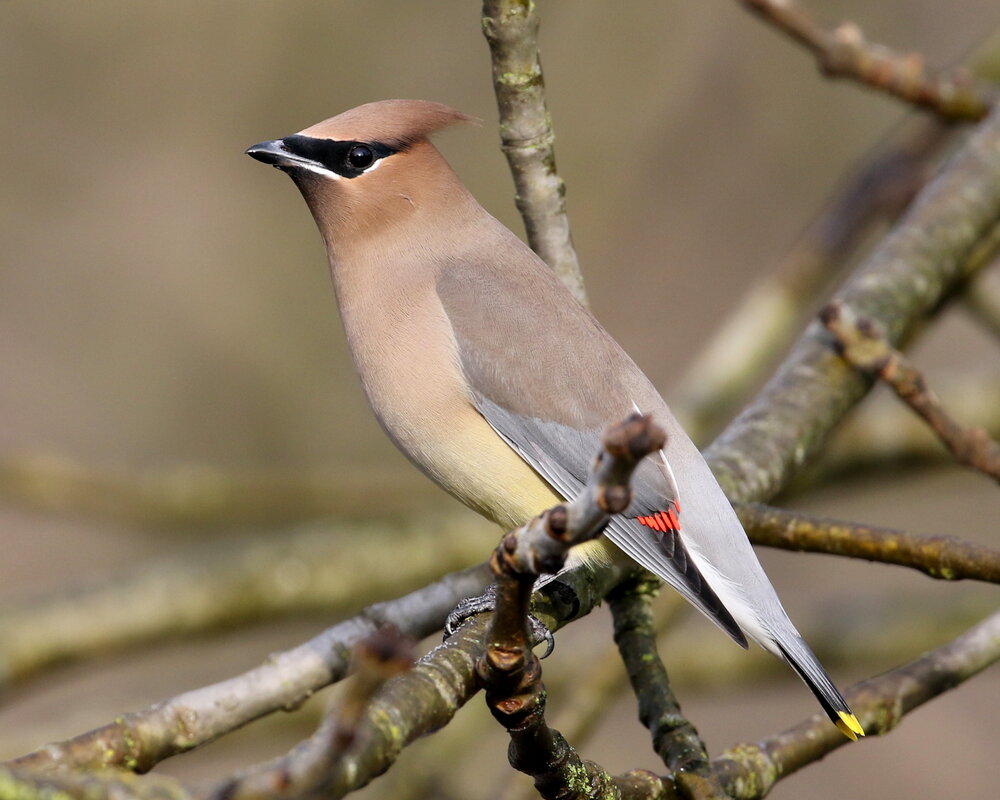
While not abundant in Alaska, Cedar Waxwings can be spotted during the summer, typically from mid-June to November in the southeastern region of the state.
Cedar Waxwings are elegant, social birds with pale brown heads, chests, and crests that fade to gray on their backs, wings, and tails.
Their bellies display a pale yellow color, transitioning to bright yellow towards the tail. They also possess a narrow black mask over their eyes and bright red wingtips.
- Bombycilla cedrorum
- Length: 5.5-6.7 inches (14-17 cm)
- Weight: 1.1 ounce (32 g)
- Wingspan: 8.7-11.8 inches (22-30 cm)
Cedar Waxwings remain year-round in the northern half of the United States. Individuals breeding in Canada migrate to the southern half of the US for winter.
These birds emit high-pitched calls and can be found in berry bushes, woodlands, and streams.
To attract Cedar Waxwings to your backyard, plant native trees and shrubs that produce small fruits such as serviceberry, dogwood, juniper, winterberry, and hawthorn. Fruit can also be offered on platform feeders.
16. Chipping Sparrow

Chipping Sparrows are summer visitors to Alaska, appearing from May to September. They can be found in open areas, including yards, fields, and woodlands.
- Spizella passerina
- Length: 4.7-5.9 inches (12-15 cm)
- Weight: 0.4-0.6 ounce (11-17 g)
- Wingspan: 7.9-9.1 inches (20-23 cm)
Chipping Sparrows have brownish-gray backs and white undersides with a reddish-brown cap. They are known for their distinctive, repetitive chip-like song.
These sparrows primarily feed on seeds and insects. They can often be seen foraging on the ground or perched on shrubs and trees.
17. Fox Sparrow
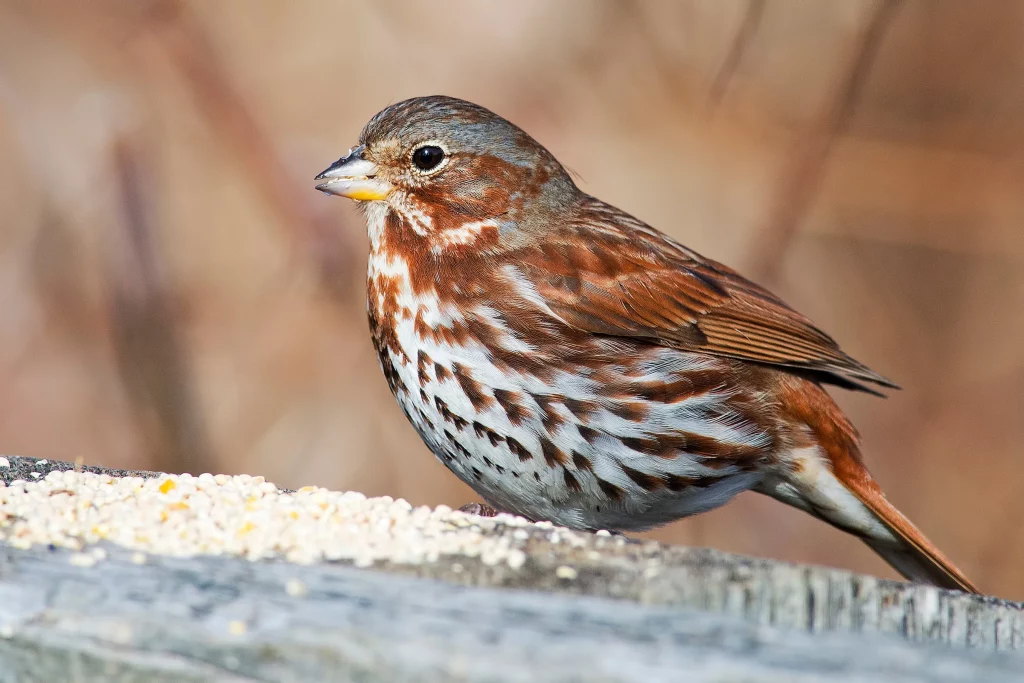
Fox Sparrows are migratory birds in Alaska, mainly observed during the spring and fall migrations. They can be found in a variety of habitats, including forests, shrubs, and gardens.
- Passerella iliaca
- Length: 5.9-7.9 inches (15-20 cm)
- Weight: 1.3-1.8 ounces (37-51 g)
- Wingspan: 9.8-11.8 inches (25-30 cm)
Fox Sparrows have a rusty-brown plumage with heavily streaked underparts. They display a rich, melodious song.
Their diet consists of seeds, insects, and berries. They are known for their scratching behavior, kicking up leaf litter to uncover food.
18. Lincoln’s Sparrow

Lincoln’s Sparrows are summer visitors to Alaska, appearing from May to September. They can be found in wetland areas, including marshes, bogs, and meadows.
- Melospiza lincolnii
- Length: 4.7-5.9 inches (12-15 cm)
- Weight: 0.4-0.6 ounce (11-17 g)
- Wingspan: 7.9-9.1 inches (20-23 cm)
Lincoln’s Sparrows have a streaked brown back, buffy breast, and a distinctive gray face with a buff-colored line above the eye.
They primarily feed on insects, spiders, and seeds. They forage on the ground, often near water sources.
19. Rusty Blackbird
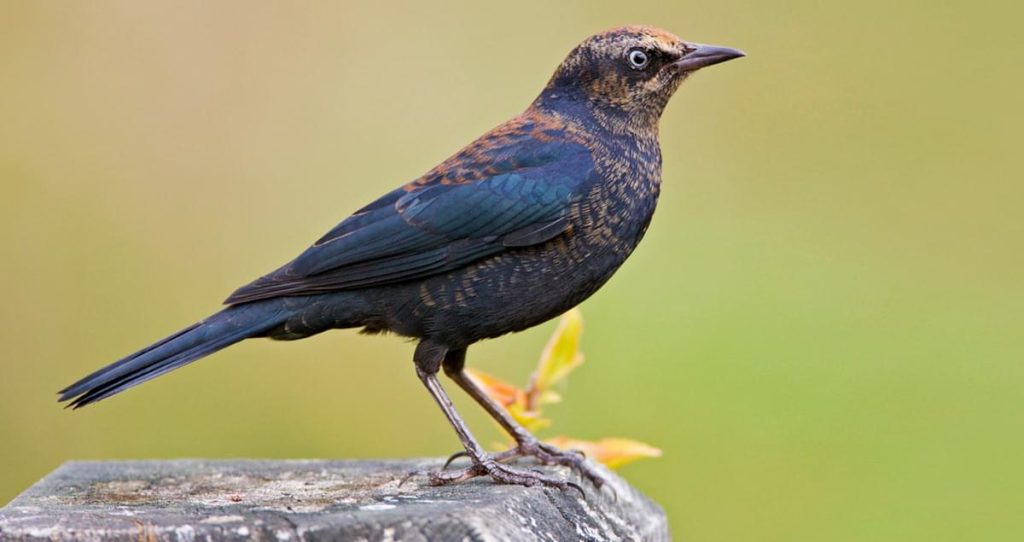
Rusty Blackbirds are migratory birds in Alaska, primarily observed during the spring and fall migrations. They can be found in wetland areas, including marshes, swamps, and forested bogs.
- Euphagus carolinus
- Length: 8.3-9.8 inches (21-25 cm)
- Weight: 1.6-2.3 ounces (45-65 g)
- Wingspan: 13.8-15.4 inches (35-39 cm)
Rusty Blackbirds have a glossy black plumage with rusty feather edges, especially noticeable on their heads. The females are slightly duller in appearance.
Their diet consists of insects, seeds, and berries. They often forage by probing in the mud or leaf litter.
20. Varied Thrush
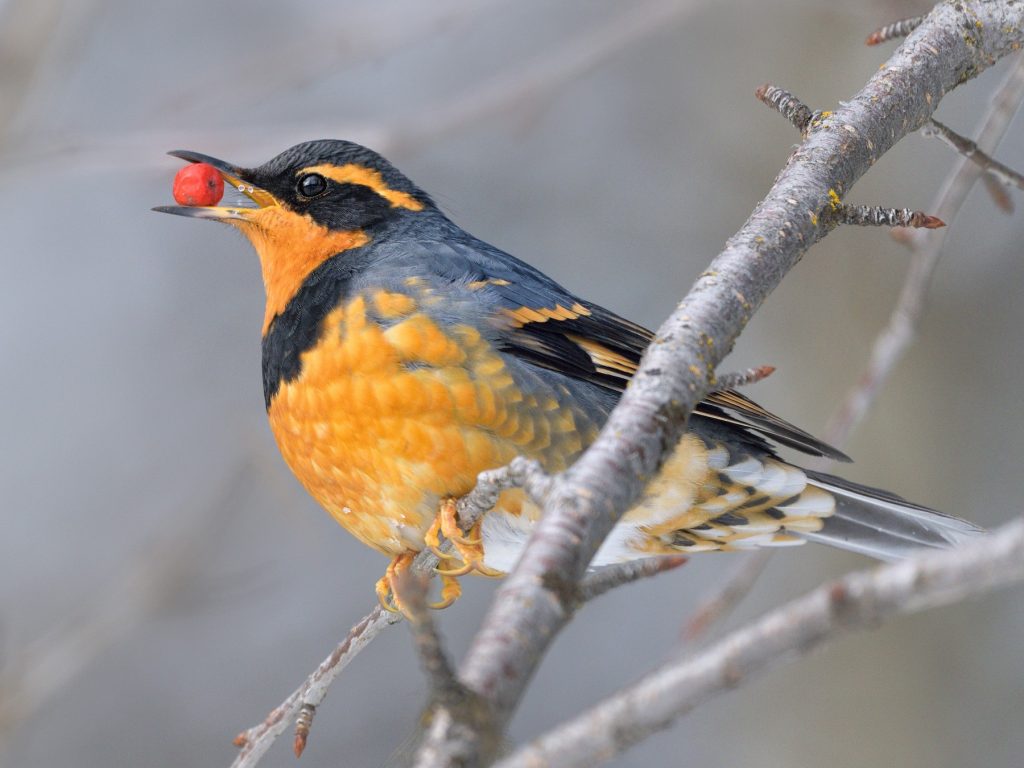
Varied Thrushes are residents of Alaska, present throughout the year. They can be found in forested areas, including coniferous forests and riparian habitats.
- Ixoreus naevius
- Length: 8.3-9.8 inches (21-25 cm)
- Weight: 1.6-2.3 ounces (45-65 g)
- Wingspan: 13.8-15.4 inches (35-39 cm)
Varied Thrushes have a dark bluish-gray back, orange underparts, and a bold black breast band. The males display a distinctive, flute-like song.
They primarily feed on insects, berries, and seeds. They can be seen foraging on the ground or perched on low branches.
21. Gray-crowned Rosy-Finch

Gray-crowned Rosy-Finches are residents of Alaska, present throughout the year. They can be found in alpine areas, including mountain slopes, tundra, and rocky outcrops.
- Leucosticte tephrocotis
- Length: 6.7-7.5 inches (17-19 cm)
- Weight: 1.1-1.3 ounces (31-37 g)
- Wingspan: 11.4-12.2 inches (29-31 cm)
Gray-crowned Rosy-Finches have a grayish-brown plumage with a pinkish wash on their bellies and rosy-colored feathers on their wings and rumps.
They primarily feed on seeds, including those from grasses and flowering plants. They forage on the ground or in low vegetation.
22. Lapland Longspur

Lapland Longspurs are migratory birds in Alaska, mainly observed during the spring and fall migrations. They can be found in open areas, including tundra, fields, and shorelines.
- Calcarius lapponicus
- Length: 5.9-6.7 inches (15-17 cm)
- Weight: 1.1-1.4 ounces (30-40 g)
- Wingspan: 10.2-11.4 inches (26-29 cm)
Lapland Longspurs have a streaked brown back, pale underparts, and distinctive white outer tail feathers that are visible during flight.
They primarily feed on seeds, including those from grasses and weeds. They often forage on the ground, forming flocks during migration.
23. Snow Bunting

Snow Buntings are winter visitors to Alaska, typically seen from October to April. They can be found in open areas, including tundra, coastal areas, and fields.
- Plectrophenax nivalis
- Length: 6.7-7.5 inches (17-19 cm)
- Weight: 1.1-1.4 ounces (30-40 g)
- Wingspan: 12.2-13.0 inches (31-33 cm)
Snow Buntings have a mostly white plumage with black wingtips, a black tail, and a rusty-brown patch on their back and sides during the breeding season.
They primarily feed on seeds, including those from grasses and weeds. They often forage on the ground, forming large flocks.
24. Boreal Chickadee

Boreal Chickadees are residents of Alaska, present throughout the year. They can be found in coniferous forests, including spruce and fir stands.
- Poecile hudsonicus
- Length: 4.7-5.9 inches (12-15 cm)
- Weight: 0.4-0.6 ounce (11-17 g)
- Wingspan: 7.9-9.1 inches (20-23 cm)
Boreal Chickadees have a grayish-brown back, buffy underparts, and a distinctive black cap extending to the sides of their heads.
They primarily feed on insects and seeds. They can often be seen foraging in trees and shrubs.
25. Northern Shrike
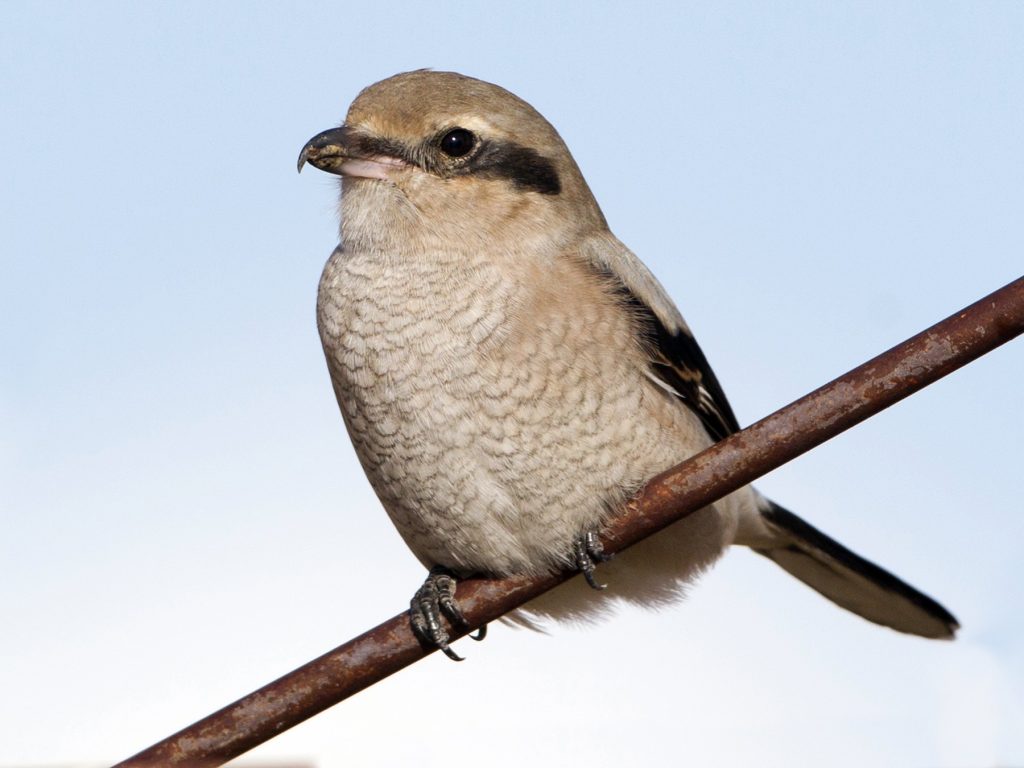
Northern Shrikes are winter visitors to Alaska, typically seen from October to April. They can be found in open areas, including tundra, fields, and forest edges.
- Lanius borealis
- Length: 9.1-9.8 inches (23-25 cm)
- Weight: 2.0-2.5 ounces (57-71 g)
- Wingspan: 10.6-12.2 inches (27-31 cm)
Northern Shrikes have a grayish-brown plumage with a black mask extending across their eyes. They have a hooked bill and a hooked tip on their upper beak.
They primarily feed on insects, small mammals, and birds. They are known for impaling their prey on thorns or barbed wire for later consumption.
26. Wilson’s Warbler
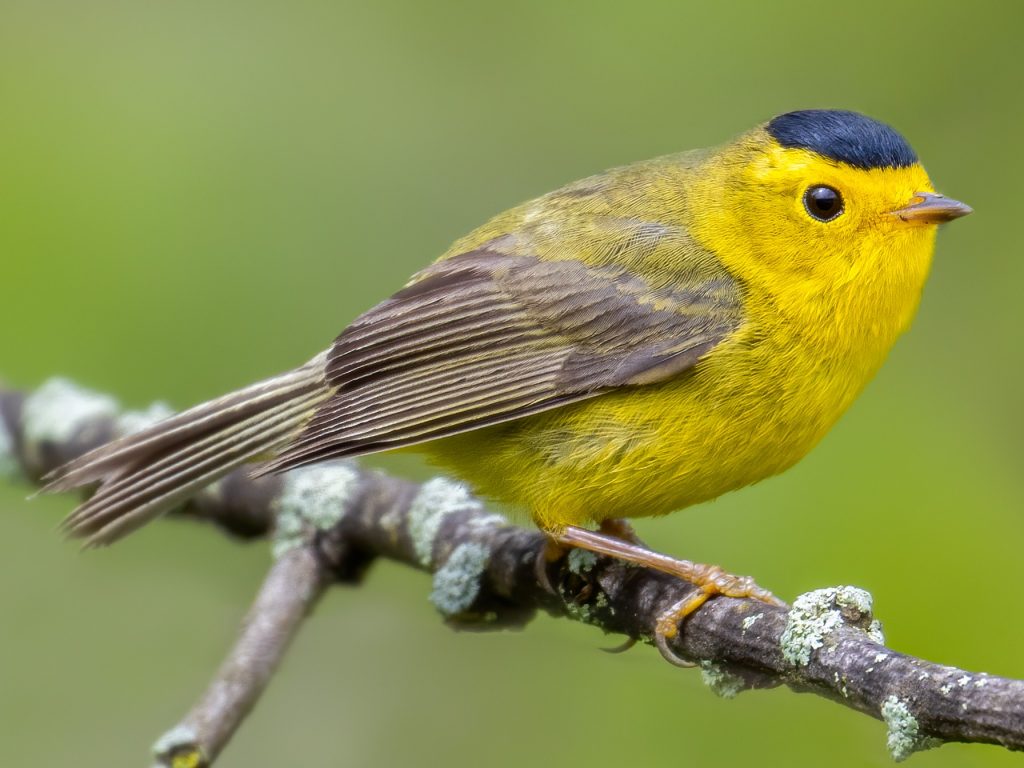
Wilson’s Warblers are migratory birds in Alaska, mainly observed during the spring and fall migrations. They can be found in various habitats, including forests, shrubs, and gardens.
- Cardellina pusilla
- Length: 4.3-4.7 inches (11-12 cm)
- Weight: 0.2-0.3 ounce (5-9 g)
- Wingspan: 6.7-7.5 inches (17-19 cm)
Wilson’s Warblers have a bright yellow plumage with a black cap on the males. Females have a lighter yellow color and a grayish cap.
They primarily feed on insects and spiders. They forage in foliage, often flicking their wings and tails.
27. Yellow Warbler
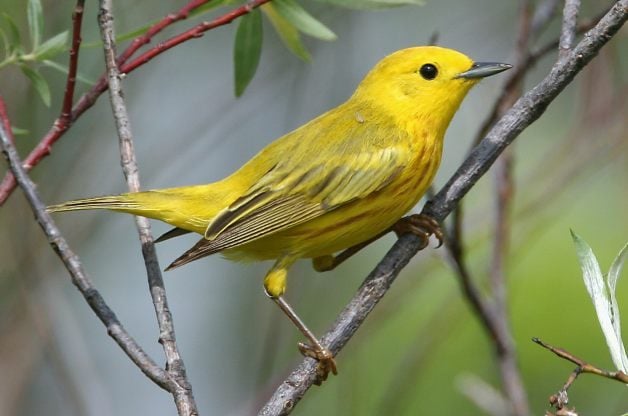
Yellow Warblers are summer visitors to Alaska, appearing from May to September. They can be found in various habitats, including forests, wetlands, and gardens.
- Setophaga petechia
- Length: 4.7-5.1 inches (12-13 cm)
- Weight: 0.3-0.4 ounce (8-12 g)
- Wingspan: 6.7-7.5 inches (17-19 cm)
Yellow Warblers have a bright yellow plumage with red streaks on their chests. Males display reddish-brown streaks on their heads.
They primarily feed on insects and spiders. They forage in trees and shrubs, often hanging upside down to search for food.
28. Orange-crowned Warbler
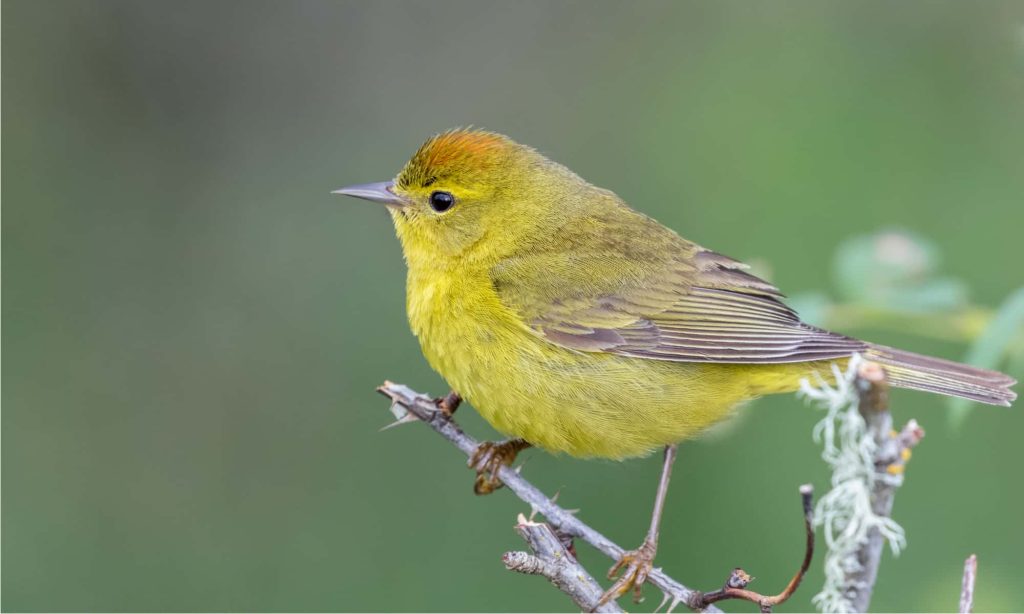
Orange-crowned Warblers are migratory birds in Alaska, mainly observed during the spring and fall migrations. They can be found in various habitats, including forests, shrubs, and gardens.
- Leiothlypis celata
- Length: 4.7-5.1 inches (12-13 cm)
- Weight: 0.3-0.4 ounce (8-12 g)
- Wingspan: 6.7-7.5 inches (17-19 cm)
Orange-crowned Warblers have a dull olive-green plumage with a yellowish belly. They often have an inconspicuous orange crown patch that is not always visible.
They primarily feed on insects and spiders. They forage in shrubs and trees, often staying hidden within the foliage.
29. Palm Warbler
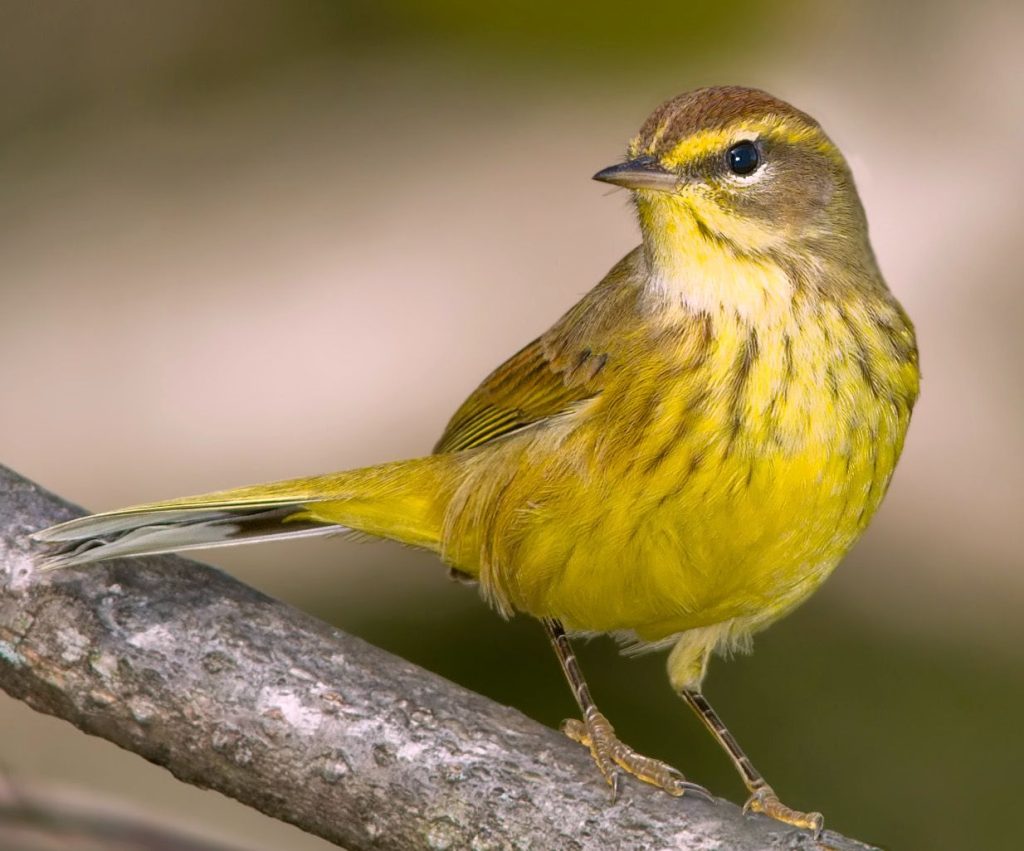
Palm Warblers are migratory birds in Alaska, mainly observed during the spring and fall migrations. They can be found in various habitats, including forests, fields, and wetlands.
- Setophaga palmarum
- Length: 4.7-5.1 inches (12-13 cm)
- Weight: 0.3-0.4 ounce (8-12 g)
- Wingspan: 6.7-7.5 inches (17-19 cm)
Palm Warblers have a brownish-olive plumage with a yellow belly and a rusty cap. They often wag their tails while foraging.
They primarily feed on insects and spiders. They forage on the ground or low in vegetation.
30. Snowy Owl

Snowy Owls are winter visitors to Alaska, typically seen from October to April. They can be found in open areas, including tundra, coastal areas, and fields.
- Bubo scandiacus
- Length: 20.5-27.9 inches (52-71 cm)
- Weight: 56.4-104.1 ounces (1600-2950 g)
- Wingspan: 49.6-57.1 inches (126-145 cm)
Snowy Owls have a white plumage with varying amounts of black barring and spotting. Males are usually whiter than females.
They primarily feed on small mammals, including lemmings and voles. They are skilled hunters, often perching on elevated spots to scan for prey.
31. Gyrfalcon

Gyrfalcons are residents of Alaska, present throughout the year. They can be found in various habitats, including tundra, cliffs, and mountainous regions.
- Falco rusticolus
- Length: 18.9-24.0 inches (48-61 cm)
- Weight: 35.3-64.4 ounces (1000-1830 g)
- Wingspan: 41.3-47.2 inches (105-120 cm)
Gyrfalcons have a gray or white plumage with varying amounts of darker markings. They are powerful raptors with broad wings and a distinctive facial pattern.
They primarily feed on birds, including ptarmigans and waterfowl. They are known for their incredible speed and agility in flight.
With these additional entries, you now have a comprehensive list of 31 brown birds found in Alaska. Enjoy your birdwatching adventures in the beautiful landscapes of Alaska!
